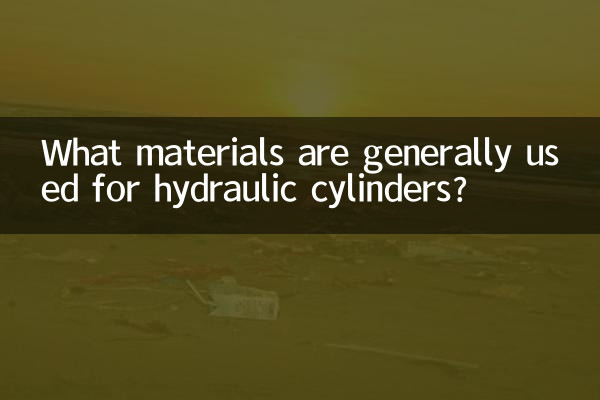What materials are generally used for hydraulic cylinders?
As the core component of the hydraulic system, the choice of materials for hydraulic cylinders directly affects performance, life and safety. This article will combine the hot topics and hot content on the Internet in the past 10 days, conduct a detailed analysis of commonly used materials and properties of hydraulic cylinders, and display key information through structured data.
1. Overview of hydraulic cylinder materials

A hydraulic cylinder is mainly composed of a cylinder barrel, a piston rod, an end cover and a seal. Different components have different material requirements. The following are common materials and properties of major components:
| Part name | Commonly used materials | Features |
|---|---|---|
| Cylinder barrel | No. 45 steel, 27SiMn, stainless steel | High strength, wear resistance and corrosion resistance |
| Piston rod | 40Cr, stainless steel, chrome plated steel | High hardness, friction resistance, rust prevention |
| end cap | HT250, aluminum alloy | Lightweight, easy to process, low cost |
| Seals | Nitrile rubber, polyurethane | Oil resistant, high temperature resistant, good elasticity |
2. Analysis of hot topic correlations
Recently, the environmental protection and lightweight of hydraulic cylinder materials have become hot topics in the industry. The following are the focus issues that netizens are paying attention to:
1.Environmentally friendly materials application: As environmental regulations become stricter, alternatives to chromium plating (such as ceramic coatings) in hydraulic cylinder materials have attracted much attention.
2.Lightweight trend: The application proportion of aluminum alloys and composite materials in hydraulic cylinders is increasing, especially in the field of construction machinery.
3.Cost and performance balance: The search volume for cost-effective steel products such as 27SiMn increased by 15% month-on-month, reflecting the market's preference for economical solutions.
3. Material performance comparison
The following is a detailed parameter comparison of three mainstream cylinder materials:
| Material type | Tensile strength (MPa) | Hardness(HB) | Corrosion resistance | Typical applications |
|---|---|---|---|---|
| 45 gauge steel | 600-800 | 170-220 | medium | General industrial hydraulic cylinder |
| 27SiMn | 1000-1200 | 260-300 | better | High voltage heavy equipment |
| 304 stainless steel | 520-750 | 150-200 | Excellent | Food/Medical Equipment |
4. Material selection suggestions
1.Normal working conditions: No. 45 steel is recommended, it is economical and can meet most needs.
2.high pressure environment: Choose 27SiMn or 42CrMo, whose high strength properties ensure safety.
3.corrosive environment: Stainless steel material is preferred, or surface treatment technology is added.
4.mobile device: Considering the aluminum alloy cylinder barrel, the weight reduction can reach 30%-40%.
5. Industry development trends
According to the latest industry report, the hydraulic cylinder material market will show the following changes in 2023:
| trend direction | Specific performance | growth rate |
|---|---|---|
| Composite material applications | Carbon fiber reinforced cylinder pilot | +18% |
| Surface treatment technology | Laser cladding replaces electroplating | +25% |
| Smart material research and development | Self-healing coating technology | laboratory stage |
In summary, the selection of hydraulic cylinder materials requires comprehensive consideration of working conditions, cost budget and technology development trends. With breakthroughs in new material technology, hydraulic cylinders will develop in the direction of being lighter, stronger, and more environmentally friendly in the future.

check the details

check the details